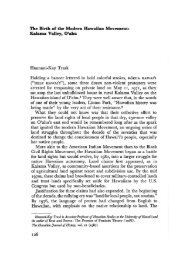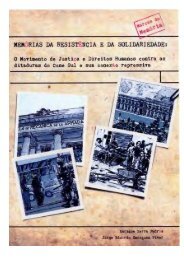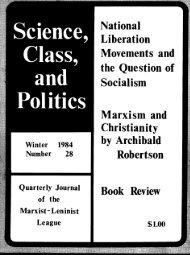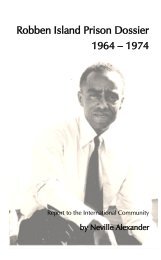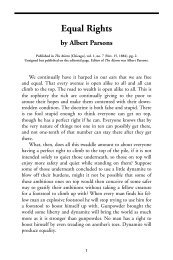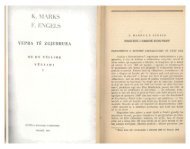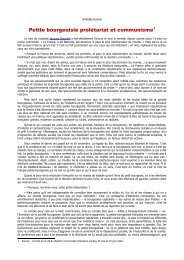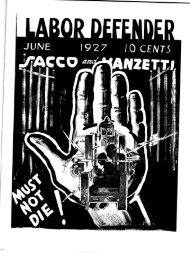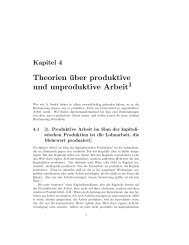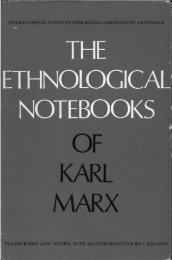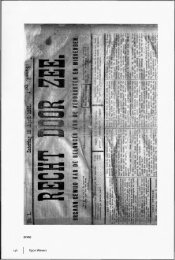Volume 6, No. 2, June, 1918
Volume 6, No. 2, June, 1918
Volume 6, No. 2, June, 1918
Create successful ePaper yourself
Turn your PDF publications into a flip-book with our unique Google optimized e-Paper software.
Page eight The Internationalist<br />
to select a retired community for the reception of the 144,-<br />
000 saints during the last days of trial. Accordingly, he arranged<br />
to buy 2500 acres of land in the Allehenies, in Pennsylvania.<br />
The land was solemnly deeded to Almighty God.<br />
The Armstrong family renounced allegiance to all earthly<br />
govemmenis, and then for nine years he, his wife and seven<br />
children iabored in preparing the land for the future work.<br />
Finally they were jcmed by fouj others. He published :i<br />
paper at the h. !-.;e, which he called "Celesi:>," termed the<br />
Day Star of Zion, which attained a moderate cirrula'.jO.i and<br />
awakened much enthusiasm. It appeared that hundred; were<br />
ready to join the colony, when, being unable to make a<br />
living, Armstrong abandoned the land and moved to Philadelphia.<br />
During the Millerite excitement in 1843, Frederick T. Howland<br />
founded a colony on the farm of Leonard Fuller in the<br />
neighborhood of Boston, called Adonai-Shomo. Some of<br />
the colonists introduced revolting practices and made extravagant<br />
claims that resulted in the breaking up of the colony.<br />
The Mennonites, Germans who lived in Russia, fled from<br />
Europe to avoid going to war, and established numerous communities<br />
in various portions of the United States. Each of<br />
these communities bought about 30,000 acres of land and<br />
contained some 125 members. They farmed, raised stock,<br />
and prospered. Many of the communities still exist, the colonists<br />
commanding high esteem from their neighbors, and<br />
being financially well fixed.<br />
Thomas L. Harris, after a successful ministry in other<br />
churches, became a spiritist and founded, in 1 85 1 , the Mountain<br />
Cove community of spiritists. The experiment was short<br />
lived. Afterward he founded the Brockton community in<br />
New York. It attracted men and women of culture. This<br />
failed, and he later established a colony in California, at<br />
Santa Rosa. Here he started what he called The Brotherhood<br />
of the New Life.<br />
Cyrus W. Teed, who called himself Koresh, devised a<br />
new<br />
system of cosmogony and religion, and attracted followers,<br />
leading them to the establishment of a colony at Eastero,<br />
Floriad. The colony is still in existence, although its founder<br />
has passed on. He claimed to be under supernatural control.<br />
At Benton Harbor, Michigan, "Benjamin and Mary" have<br />
a community which they call The House of David. There are<br />
colonies with similar religious tenets at other points. They<br />
prosper and have many conveniences and beautiful surroundings<br />
in their communistic homes.<br />
Dr. J. B. Newbrough, of New York City, about 1882 published<br />
a large and striking volume, called "Oahspe," purporting<br />
to have been received from the spirit world by automatic<br />
writing. One of its instructions was to take New York waifs<br />
and raise them into good citizens in a community far re-<br />
,<br />
moved from contaminating influences. Accordingly, a community<br />
was established later on in New Mexico , called<br />
Shalem, and referred to as the Children's land. Inhabitants<br />
of the community were allowed to live much as they<br />
pleased, except that they were not allowed to own houses or<br />
lands that they did not actually use, and had to contribute<br />
a tenth of their income to the support of the orphans that<br />
were brought in from the slums of the cities. Many children<br />
were raised into good citizenship. But the community fell<br />
into disuse when the children who were adopted at its inception<br />
grew up. The cult based on Oaspe, however, is a<br />
growing force to this day.<br />
o o o<br />
III.<br />
SOCIALIST COMMUNITIES<br />
Robert Owen had dreamed of a colony in Mexico. In<br />
1 870 Albert K. Owen, a civil engineer, no relation of Robert,<br />
came upon an inland sea in Mexico, which the Indians called<br />
lopolombampo. The site charmed him, and he interested<br />
others in the project that came to him, of starting a communistic<br />
colony there. They obtained a grant of 30,000<br />
acres from the Mexican government. The land was laid out,<br />
a third being devoted to public grounds, parks and sites for<br />
founders were not prepared for such a contingency, and<br />
public buildings. Then advertisements were inserted in many<br />
papers for colonists. Hundreds without means, and sometimes<br />
without health, appeared at the colony site. The<br />
appeal had to be made for funds to support the colonists<br />
until buildings could be erected and land brought under cultivation.<br />
The ground was poor and far from markets.<br />
The colony finally was moved to the coast. Here a system<br />
of irrigation was land out and begun. But dissentions entered<br />
into this purely socialistic colony, many deserted, and<br />
finally the Mexican government cancelled the grant, and the<br />
enterprise collapsed. The widespread interest it had awakened<br />
is shown in that seventeen states of the United Stats,<br />
besides Canada and Mexico, were represented among the<br />
colonistts.<br />
After J. A. Wayland made a success of the "Coming Nation"<br />
at Greensburg, Indiana, he projected the Ruskin colony<br />
at Ruskin, Tenn. Everyone who contributed $100 or<br />
secured 200 subscribers to the paper was reckoned a member.<br />
The land was bought without being seen and was of<br />
poor quality. The colonists went on this land, and had to<br />
cut timber and build huts in which to live. The newspaper<br />
moved to this primitive camp. Conditions were so bad<br />
during the first winter that the suffering colonists were moved<br />
to seek a new location. They now selected land with a fine<br />
cave and spring on it, still in Tennessee. Here they planned<br />
big things. They had a rousing Fourth of July celebration<br />
in the cave. The colony grew, and built, beside many residences,<br />
a large printing office, a public hall and other improvements.<br />
A college was started, and the paper boomed.<br />
But dissentions entered. Wayland finally withdrew from the<br />
colony. The land and personal property was disposed of at<br />
public sale, and the colony removed to Duke, Ga. Here over<br />
fifty houses were built, a store, repair shop and public hall<br />
erected; manufacture of a cereal coffee, of leather suspenders<br />
and of brooms were started; a library of 1500 volumes<br />
was founded and woman's clubs were organized. But dissatisfaction<br />
entered again. Some of the colonists deserted.<br />
Others wanted to move back to Tennessee. A few months<br />
later the property of the colony was sold at public auction<br />
and the proceeds divided among the members. The "Coming<br />
Nation" was discontinued. It was afterwards revived by the<br />
Warren brothers, E. N. Richardson and the writer of this,<br />
at Rich Hill, Mo., and then again fell into the hands of J. A.<br />
Wayland by purchase.<br />
The Colorado Co-operative Company was established by<br />
socialists. It claimed to have attained a membership of 300.<br />
It was short lived.<br />
The Brotherhood Co-operative Commonwealth of Equality<br />
was established by socialists at Equality, Washington, in<br />
1895. The colony existed until 1904 when it went to pieces<br />
over internal dissentions.<br />
A Co-operative Brotherhood was started at Burley, Washington,<br />
by socialists, in 1898. It gained members from many<br />
states and started apparently under favorable conditions. A<br />
reorganization later on eliminated many of the co-operative<br />
features, and the membership rapidly disintegrated.<br />
The Mutual Home Association was a socialistic community<br />
founded at Home, Washington, in 1898. It attained a membership<br />
of 155, and then went out of existence.



